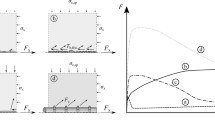Abstract
The performance of concrete is dictated mostly by the characteristics of the transition zone. Internal bleeding leads to a higher effective water/cement ratio and hence a more open, porous structure at the cement/aggregate interface. Besides, more of AFt, AFm and CH phases and halides, sulphate, alkalis and other admixture components and less of C-S-H are found in this zone. These cause the deterioration of the reinforcing materials like steel, silicious aggregates, glass and natural fibres. The orientation of the crystalline phases parallel to the interface also weakens the mortar. The porosity and related effects are considerably modified by the use of plasticizers, fine pozzolanic additives and reduced water cement ratio. The mechanism of interfacial structure formation and their resulting effects on the reinforcement are discussed together with the possible precautionary measures.
Similar content being viewed by others
References
Akers S A S and Garrett G G 1983J. Mater. Sci. 18 2200
Anonian R, Mai Y W and Cotterell B 1979Int. J. Cem. Comp. Lightweight Concr. 1 151
Arligiue G, Grandet J and Ollivier J P 1985Mater. Constr. 18 263
Barnes B D, Diamond S and Dolch W L 1978Cem. Concr. Res. 8 233
Barnes B D, Diamond S and Dolch W L 1979J. Am. Ceram. Soc. 62 21
Barthos P 1981Int. J. Cem. Comp. Lightweight Concr. 3 159
Bentur A and Diamond S 1984Cem. Concr. Res. 14 31
Bentur A, Diamond S and Mindess S 1985aJ. Mater. Sci. 20 3610
Bentur A, Mindess S and Diamond S 1985bInt. J. Cem. Comp. Lightweight Concr. 17 29
Carles-Gibergues A, Grandet J and Ollivier J P 1982Proc. Conf. on Bond in concrete, Paisley; 24
Cojeaud M, Lelong B and Cariou B 1980Proc. 7th Int. Cong. Chem. Cem., Paris; III, VIII-6
Coutts R S P 1984Composites 15 139
Coutts R S P 1990J. Mater. Sci. Lett. 9 1235
Coutts R S P and Kighty P 1984J. Mater. Sci. 19 3355
Cussino L and Negro L 1980Proc. 7th Int. Cong. Chem. Cem., Paris; III, V-62
Dave N J and Ellis D G 1979Int. J. Cem. Comp. Lightweight Concr. 1 19
Diamond S 1983Proc. 6th Int. Conf. on Alkalies in concrete, Copenhagen 155
Diamond S and Gomez-Toledo C 1978Cem. Concr. Res. 8 613
Grandet J and Ollivier J P 1980aProc. 7th Int. Cong. Chem. Cem., Paris; III, VII-85
Grandet J and Ollivier J P 1980bProc. 7th Int. Cong. Chem. Cem., Paris; III, VII-63
Grandet J and Ollivier J P 1980cCem. Concr. Res. 10 759
Hsu T C, Slate F O, Sturman G M and Winter G 1963J. Am. Concr. Inst. 60 209
James J 1991 in ‘Cement and concrete: Science and technology’ (ed.) S N Ghosh (New Delhi: ABI Books Ltd) (In print)
James J and SubbaRao M 1986Cem. Concr. Res. 16 67
James J and SubbaRao M 1987Il Cemento 84 383
James J and SubbaRao M 1988Il Cemento 85 101
Khalaf M N Al and Page C L 1979Cem. Concr. Res. 9 197
Khalaf M N Al, Page C L and Ritchie A G B 1980Cem. Concr. Res. 10 71
Langton C A and Roy D M 1980Proc. 7th Int. Cong. Chem. Cem. Paris III, VII-127
Mai Y W, Hakeem M I and Cotterell B 1983J. Mater. Sci. 18 2156
Massazza F and Costa U 1986Proc. 8th Int. Cong. Chem. Cem.; Brazil;1 158
Massazza F and Pezzuoli M 1980Proc. 7th Int. Cong. Chem. Cem. Paris; III, VII-16
Mindess S 1986Proc. 8th Int. Cong. Chem. Cem. Brazil 1 151
Mindess S and Bentur A 1982Int. J. Cem. Comp. Lightweight Concr. 4 245
Mindess S and Diamond S 1982Cem. Concr. Res. 12 569
Monteiro P J M, Maso J C and Ollivier J P 1985Cem. Concr. Res. 15 953
Monteiro P J M and Mehta P K 1985Cem. Concr. Res. 15 378
Monteiro P J M and Mehta P K 1986Cem. Concr. Res. 16 111, 127
Nayeb Hashemi H and Cohen M D 1985Cem. Concr. Res. 15 879
Page C L 1982Composites 13 140
Page C L, Khalaf M N Al and Ritchie A G B 1978Cem. Concr. Res. 8 481
Perry C and Gillott J E 1977Cem. Concr. Res. 7 553
Perry C and Gillott J E 1983Durability of building materials 1 305
Pinchin D J and Tabor D 1978Cem. Concr. Res. 8 15
Rossler M and Odler I 1985Cem. Concr. Res. 15 320
Roy D M 1987Science 235 651
Sing B and Majumdar A J 1985J. Mater. Sci. Lett. 4 967
Skalny J and Mindess S 1985Mater. Sci. Monogr. V-28a (React. Solids A), 517
Struble L and Mindess S 1983Int. J. Cem. Comp. Lightweight Concr. 5 79
Stucke M S and Majumdar A J 1976J. Mater. Sci. 11 1019
Tashiro C and Ueoka K 1981Cem. Concr. Res. 11 619
Thomas N L 1987J. Mater. Sci. 22 3328
Turriziani R 1986Proc. 8th Int. Cong. Chem. Cem., Brazil 4·3, 388
Watton P L and Majumdar A J 1975Composites 6 209
Author information
Authors and Affiliations
Rights and permissions
About this article
Cite this article
James, J. Interface-durability correlations in concrete. Bull. Mater. Sci. 14, 1183–1195 (1991). https://doi.org/10.1007/BF02744611
Received:
Revised:
Issue Date:
DOI: https://doi.org/10.1007/BF02744611




